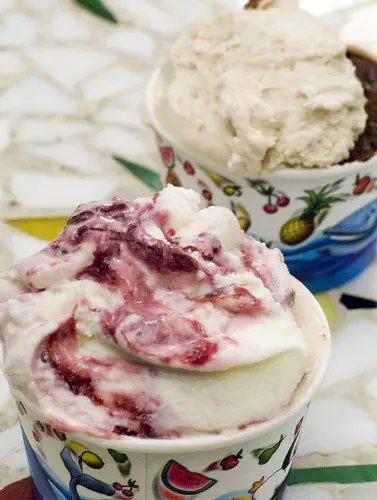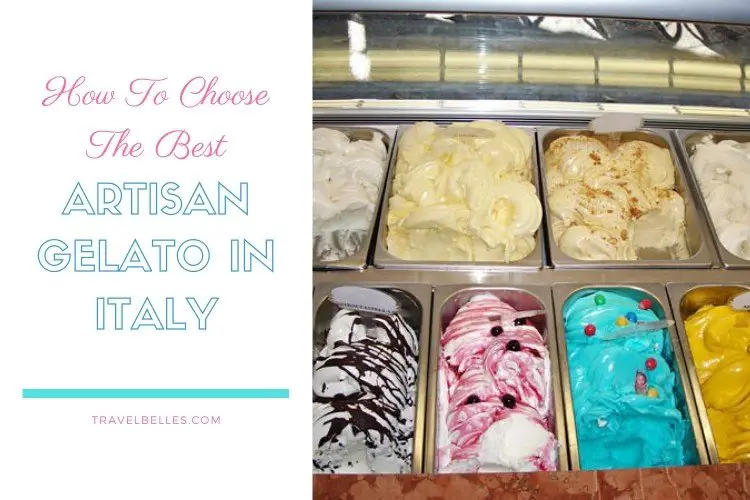Artisan gelato: A primer on how to find the best gelato in Italy
His highness Gelato, appreciated in every season across Italy, during summer undergoes a new youth, renovating and reforming itself; taking on novel colors and flavors that conquer the needy palates of Romans and foreigners alike.

Despite the alarming growth of artificial and industrially manufactured ice cream in Italy, the quality battle keeps being won by the ages-old tradition of plain and healthy homemade gelato.
In the name of gelato love and in the pursuit of true artisan gelato, there are 6 key elements that need to be observed:
a) Volume
b) Color
c) Texture
d) Temperature
e) Ingredients
f) Freshness

Volume ~ When the flavor display case features frothy, excessively sculpted and overabundant mounds of gelato it means that–besides water, milk, cream, sugar, and fruit, cacao or nut flavorings, there’s been an abuse of a sixth ingredient: air. In some cases, so much air is injected into the gelato during production, that half of it by volume is composed of air. Artisan gelato has a much smaller percentage of air.
Color ~ Are you comfortable eating something blue? I’m not. Hardly anything in nature that is edible is blue. So why choose scoops of blue Smurf ice cream for your cone? Natural ingredients, when mixed with milk, cream, sugar and water, and then churned at low temperatures to obtain creamy gelato, naturally lose pigment.
Take pistachio gelato, for example. We are used to it being bright green, right? Well, ground pistachios from Bronte in Sicily–the best in the world–that have become gelato, are a pale shade of sage hinting towards beige. Strawberry gelato should never be fuchsia, it should be pale pink. And have seeds! The same goes for all those fruit flavors that are enhanced with food coloring to lure prospect lickers. Artisan gelato is never flashy.

Texture ~ Grainy gelato is a sin. During the gelato-making procedure–which is entirely different from that of regular ice cream–the proportions of the unique blend need to rest. This is when the proteins in the mix engage in absorbing moisture, which results in the total absence of ice crystals. Gelato should be velvety, smooth and creamy. Any presence of grainy ice in its texture means it’s not real gelato.
Artisan gelato has a clean, smooth perception on the palate. And no crystals. Ever.
Temperature ~ Gelato means, “frozen” in Italian, there’s no denying that.
But in Italy, a gelato that is too cold, is just not right. Artisan gelato is served at a warmer temperature than ice cream, which means it’s denser, creamier and more intense than traditional ice cream. A concoction that is too cold, too hard and whose flavor is numbed by frost, is not true artisan gelato.

Ingredients ~ I once witnessed a gelato artisan in a Rome gelateria send back 12 crates of peaches because according to him, they weren’t the best quality. In his usual gruff manner, the gelataio in question sent the farmer and his crates back and turned to us patrons with a dry, “No peach gelato today, sorry.” Fresh, wholesome, organic and local ingredients are always employed in artisan gelato.
There is a quality control organization that makes sure this regulation is followed closely. Also, in some countries, frozen desserts cannot be named as “ice cream” if they don’t have at least a certain content of butterfat. The butterfat content in Gelato is normally ten times less than in regular ice cream.
Freshness ~ The best artisan gelato is scooped out best in an authentic gelateria in Italy, where it is made from scratch every day. Unlike many other ice cream parlors worldwide, Italian gelato is made in a backroom behind the retail counter. Artisan gelato is not produced in large quantities and then stocked. Since there are no preservatives added to create an artificially long shelf life, gelato is made fresh for scooping within a day or two.
*Photos by Eleonora Baldwin, except for the last one which is via Jen and Joe on Flickr
Pin for Later


What a array of Gelato!
Eleonora, you are a master of display!!
Love ya:)
Love these tips! I dream of Italian gelato and now I have a hankering to head back to Italy 🙂
I’ve got the gelato and Italy hankering too! For almost a whole week now. 🙂
Bob, not that I know of, but I’ll check w/Eleonora and we’ll see what she comes with… Any particular area?
Gnomm those! Ti amo Italia, and oh how I miss it when I see stuff like this! I’m a travel blogger too btw. 🙂
Hi Jools! So sorry I missed this comment until now… (and I miss gelato, not suprisingly) I’ve been to your blog before! About train travel, right? Thanks for stopping by – I’ll head over your way again NOW.
Scrumptious photos and great advice!
I always tell travelers to Italy: “If you see yellow banana gelato–LEAVE THAT GELATERIA! Thankfully, there are so many wonderful ones all over Italy.
Ugh.. If it were real banana gelato it wouldn’t bright yellow, it be brown! Thanks for commenting! 🙂
No flash, no volume, quality ingredients, made fresh in the back room every day. Golden gelato rules to live by. 🙂 Doesn’t take long to develop refined gelato taste buds…just keep tasting, just keep tasting…
Great tips! You’re so right – it is possible to have bad ice cream in Italy, but not if you follow this advice.
Ohhh, what lovely memories you’ve brought back today. 🙂 It may be dead of winter here in Oz, but I’d still happily dig into melon gelato right this very second. 🙂